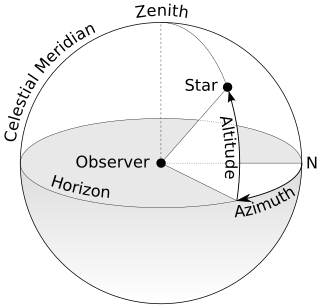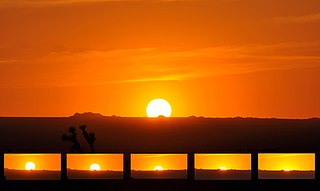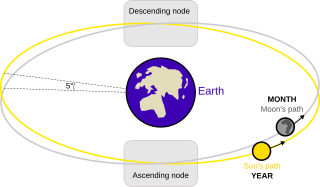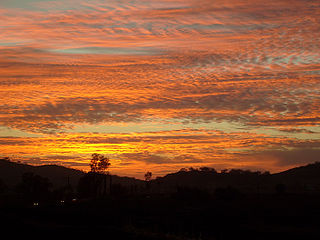
In astronomy, declination is one of the two angles that locate a point on the celestial sphere in the equatorial coordinate system, the other being hour angle. The declination angle is measured north (positive) or south (negative) of the celestial equator, along the hour circle passing through the point in question.

The full moon is the lunar phase when the Moon appears fully illuminated from Earth's perspective. This occurs when Earth is located between the Sun and the Moon. This means that the lunar hemisphere facing Earth—the near side—is completely sunlit and appears as an approximately circular disk. The full moon occurs roughly once a month.

A lunar phase or Moon phase is the apparent shape of the Moon's directly sunlit portion as viewed from the Earth. In common usage, the four major phases are the new moon, the first quarter, the full moon and the last quarter; the four minor phases are waxing crescent, waxing gibbous, waning gibbous, and waning crescent. A lunar month is the time between successive recurrences of the same phase: due to the eccentricity of the Moon's orbit, this duration is not perfectly constant but averages about 29.5 days.

The horizontal coordinate system is a celestial coordinate system that uses the observer's local horizon as the fundamental plane to define two angles: altitude and azimuth. Therefore, the horizontal coordinate system is sometimes called the az/el system, the alt/az system, or the alt-azimuth system, among others. In an altazimuth mount of a telescope, the instrument's two axes follow altitude and azimuth.

In astronomy, a conjunction occurs when two astronomical objects or spacecraft appear to be close to each other in the sky. This means they have either the same right ascension or the same ecliptic longitude, usually as observed from Earth.

A terminator or twilight zone is a moving line that divides the daylit side and the dark night side of a planetary body. The terminator is defined as the locus of points on a planet or moon where the line through the center of its parent star is tangent. An observer on the terminator of such an orbiting body with an atmosphere would experience twilight due to light scattering by particles in the gaseous layer.

A circumpolar star is a star that, as viewed from a given latitude on Earth, never sets below the horizon due to its apparent proximity to one of the celestial poles. Circumpolar stars are therefore visible from said location toward the nearest pole for the entire night on every night of the year. Others are called seasonal stars.
The heliacal rising of a star or a planet occurs annually when it first becomes visible above the eastern horizon at dawn just before sunrise after a complete orbit of the Earth around the Sun. Historically, the most important such rising is that of Sirius, which was an important feature of the Egyptian calendar and astronomical development. The rising of the Pleiades heralded the start of the Ancient Greek sailing season, using celestial navigation, as well as the farming season. Helical rising is one of several types of risings and settings, mostly they are grouped into morning and evening risings and settings of objects in the sky. Culmination in the evening and then morning is set apart by half a year, while on the other hand risings and settings in the evenings and the mornings are only at the equator set apart by half a year.
In observational astronomy, culmination is the passage of a celestial object across the observer's local meridian. These events were also known as meridian transits, used in timekeeping and navigation, and measured precisely using a transit telescope.

Sunrise is the moment when the upper rim of the Sun appears on the horizon in the morning. The term can also refer to the entire process of the solar disk crossing the horizon.

Sunset is the disappearance of the Sun below the horizon of the Earth due to its rotation. As viewed from everywhere on Earth, it is a phenomenon that happens approximately once every 24 hours, except in areas close to the poles. The equinox Sun sets due west at the moment of both the spring and autumn equinoxes. As viewed from the Northern Hemisphere, the Sun sets to the northwest in the spring and summer, and to the southwest in the autumn and winter; these seasons are reversed for the Southern Hemisphere.

A lunar node is either of the two orbital nodes of the Moon, that is, the two points at which the orbit of the Moon intersects the ecliptic. The ascending node is where the Moon moves into the northern ecliptic hemisphere, while the descending node is where the Moon enters the southern ecliptic hemisphere.

The night sky is the nighttime appearance of celestial objects like stars, planets, and the Moon, which are visible in a clear sky between sunset and sunrise, when the Sun is below the horizon.

The Moon illusion is an optical illusion which causes the Moon to appear larger near the horizon than it does higher up in the sky. It has been known since ancient times and recorded by various cultures. The explanation of this illusion is still debated.

A lunar standstill or lunistice is when the Moon reaches its furthest north or furthest south point during the course of a month. The declination at lunar standstill varies in a cycle 18.6 years long between 18.134° and 28.725°, due to lunar precession. These extremes are called the minor and major lunar standstills.

The Moon orbits Earth in the prograde direction and completes one revolution relative to the Vernal Equinox and the stars in about 27.32 days and one revolution relative to the Sun in about 29.53 days. Earth and the Moon orbit about their barycentre, which lies about 4,670 km (2,900 mi) from Earth's centre, forming a satellite system called the Earth–Moon system. On average, the distance to the Moon is about 385,000 km (239,000 mi) from Earth's centre, which corresponds to about 60 Earth radii or 1.282 light-seconds.

A total lunar eclipse occurred on 31 January 2018. The Moon was near its perigee on 30 January and as such may be described as a "supermoon", when the Moon's distance from the Earth is less than 360,000 km. The previous supermoon lunar eclipse was in September 2015.

Atmospheric optics is "the study of the optical characteristics of the atmosphere or products of atmospheric processes .... [including] temporal and spatial resolutions beyond those discernible with the naked eye". Meteorological optics is "that part of atmospheric optics concerned with the study of patterns observable with the naked eye". Nevertheless, the two terms are sometimes used interchangeably.

Earth's shadow is the shadow that Earth itself casts through its atmosphere and into outer space, toward the antisolar point. During the twilight period, the shadow's visible fringe – sometimes called the dark segment or twilight wedge – appears as a dark and diffuse band just above the horizon, most distinct when the sky is clear.

The Earth phase, Terra phase, terrestrial phase, or phase of Earth, is the shape of the directly sunlit portion of Earth as viewed from the Moon. From the Moon, the Earth phases gradually and cyclically change over the period of a synodic month, as the orbital positions of the Moon around Earth and of Earth around the Sun shift.





























